Press Release-en
MARAEY WINS THE 2021 LEADERSHIP AWARD FOR LATIN AMERICA GRANTED BY THE U.S. GREEN BUILDING COUNCIL
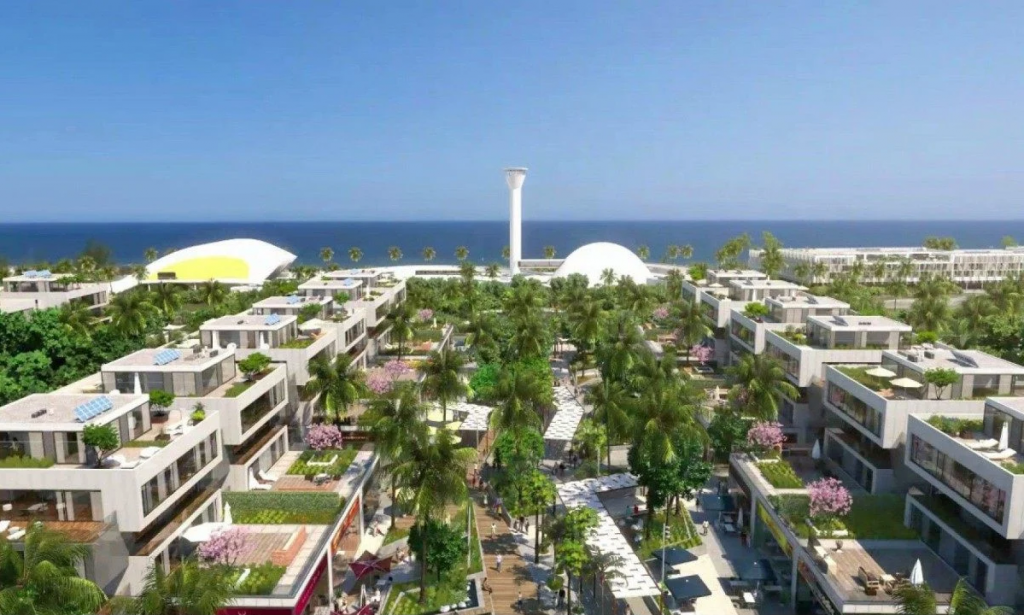
MARAEY, the main sustainable tourist-residential development in Brazil, to be built in Maricá, has just claimed the U.S. Green Building Council 2021 USGBC Leadership Award Latin America. The project was praised for the high score it obtained by achieving precertification from the Sustainable SITES Initiative® (SITES) in the GOLD category, making it the first pre-certified mixed-use project in all of South America.
“It is a huge honour for us to win such an important award granted by the U.S. Green Building Council, the world’s top certifying body for sustainable communities and buildings, thanks to LEED and SITES certifications. This is a historical framework that bolsters our core principles and values geared towards environmental protection, inclusion of the area’s communities, and sustainable economic development,” says Emilio Izquierdo, CEO of the initiative.
Mr Izquierdo also pointed out that, along with other milestones, the MARAEY team will be delivering a ground-breaking project.
El premio The USGBC Leadership Award The USGBC Leadership Award goes to outstanding projects and companies on the road to sustainability and so-called eco-friendly buildings. The award winners, who were announced during the USGBC Live opening event, are raising the bar in terms of enterprising projects and making communities more sustainable, healthy and resilient.
In MARAEY, for instance, using renewables was one of the key criteria considered when rating the project for SITES precertification. More than half of the electricity to be consumed in this vast project will be produced using renewable sources such as solar power, biogas and wind energy.
“This award acknowledges what MARAEY has achieved by becoming the first project to get SITES Gold precertification in the region. The way the undertaking is designed is proof of the team’s commitment to creating a sustainable and resilient experience that is good for the community,” explains Mahesh Ramanujam, CEO and Chairman of the U.S. Green Building Council. “We believe that healthy people in healthy places lead to a healthy economy. Through the leadership of projects like MARAEY, we know that this vision can become a global reality. It will be an honour and a privilege to keep up our leadership in order to move forward in our collective mission to shape a sustainable future for all,” added Mr Ramanujam.
Perpetual preservation of a 440-hectare Private Restinga Reserve
Building on just 6.6% of land, MARAEY intends to preserve 81% of the project’s overall surface area and create the second-largest Private Natural Heritage Reserve (RPPN) of restinga forest in the State of Rio de Janeiro and the fifth in Brazil. Covering nearly 440 hectares, the RPPN will span almost half of the overall surface of MARAEY and will be fully and perpetually protected.
Another resource used to preserve wildlife is the degraded area environmental recovery programme, as well as a plan to rescue endangered species in a nursery. Following the project’s implementation, it is estimated that native vegetation will be restored in over 120 hectares of restinga forest compared to the situation prior to MARAEY.
55% of vehicles driven in the development aim to be electric or hybrid
The project’s values also include promoting the use of sustainable vehicles. The aim is for at least 55% of the fleet driven around the complex to be electric or hybrid vehicles. This will involve setting up an electric vehicle charging infrastructure across the entire complex. MARAEY will also feature the longest cycle lane in any private real estate development in Brazil, measuring 20 km long and joining up to the Maricá network to total 57.5 km altogether.
A smart city with various types of new houses
The undertaking plans to feature a variety of dwellings: apartment blocks, duplex homes and villas. Residents will enjoy homes built according to the highest quality and design standards, with vast recreational areas and the finest health, education, sports, leisure and business services. The project also ensures top-level security everywhere, including the local community of Zacarias.
MARAEY believes in the smart city philosophy, which means widespread implementation of information and communication technologies. Smart buildings and initiatives fostering a responsible use of natural resources help make a minimal impact on the environment. The local transport system will rely on electric models to keep CO2 emissions to a minimum. Plus, the complex will boast a series of electrical connection points, smart and eco-friendly lighting, bio-based materials, dynamic façades and green roofs.
About USGBC Leadership Award
The USGBC Leadership Awards presented by USGBC Live reward exemplary leadership shown in the past year by individuals and organisations who support ecological construction around the globe. The awards also acknowledge where hard work is done to create healthy and sustainable spaces.
USGBC Live is a new event combining the expertise of the largest community of leaders in ecological construction with data, know-how, stories and leadership from thousands of LEED projects (*) and sustainable initiatives worldwide. The aim is to spark relevant debates regarding the future of buildings, cities and communities. This three-day virtual event featured different content channels located in various regions in Europe and abroad hosting debates on innovative ways of promoting industry.
(*) LEED is a certification system for sustainable buildings developed by the non-government organisation United States Green Building Council in an effort to promote and foster sustainable construction practices in compliance with eco-friendly building criteria.
About Sustainable SITES Initiative® (SITES)
Sustainable SITES Initiative® or simply SITES® certification is managed by Green Business Certification Inc. (GBCI) and consists in the most comprehensive programme for designing, developing and maintaining sustainable environments.
The SITES credits system promotes best practice in ecological restoration, landscape architecture and other similar areas. The programme supports and restores the functions of healthy ecosystems, both in urban and rural areas. From plants and soils to water and materials, SITES improves communities through responsible design, enhancing the functions of buildings by means of affordable and environmentally-friendly solutions and creating a strong link between people and nature. SITES connects design with ecology and people with places.
SITES was developed through the collaborative and interdisciplinary efforts of the American Society of Landscape Architects, the University of Texas’ Lady Bird Johnson Wildflower Center in Austin and the United States Botanic Garden.
About MARAEY
The tourist side of the undertaking will house four five-star hotels welcoming an average 300 thousand tourists per year: a magnificent eco-boutique resort, a luxury themed resort, a hotel designed to be the country’s most iconic seaside events venue, and MARAEY Golf Resort surrounding an internationally certified 18-hole golf course.
MARAEY is the world’s first private initiative to receive the BIOSPHERE seal in the “Sustainable Tourist Destination” category granted by the Responsible Tourism Institute (RTI), an organisation that emerged from a UNESCO memorandum of understanding. This certification furthers the project’s commitment to align with the 17 United Nations Sustainable Development Goals (SDGs) and the latest directives of the Paris Climate Agreement.
The development is also the first mixed-use complex in South America to achieve precertification from the Sustainable SITES Initiative in the GOLD category. Managed by Green Business Certification Inc., SITES is the world’s most widely recognised seal for the development of sustainable communities. Out of the criteria assessed, MARAEY earned credits for factors such as using renewable energy sources, water repurposing systems, sustainable mobility, preservation of native flora and fauna, and creation of an RPPN.
The project also plans to set up the María Esther Bueno Tennis & Sports Club, housing eight tennis courts including clay, grass and fast courts, making it the only sports club in Brazil to offer all three kinds found in the major international tournaments. Part of its revenue will go to social projects to drive social action in the surrounding municipalities through sport and education. MARAEY also includes an international hospitality university, making Maricá a hub for specialized training in Latin America.
The private investment forecast for the project is in order of R$ 11 billion, expecting R$ 7.2 billion to be collected in tax over the first 14 years (construction and consolidation of sales), followed by over R$ 1 billion per year once fully up and running. The economy of the State of Rio is predicted to warm up as 36 thousand jobs are created once MARAEY is in full operation.
There are around 200 fishing families living in the Zacarias community inside the area of the project who stand to gain from legalised land use and being given deeds of official ownership and residence. MARAEY will also foster the local culture and fishing with programmes to restore the Maricá Lagoon, recover native species, and bring back and raise awareness of the Zacarias family memory by creating the Craft Fisherman’s House.
MARAEY TO INVEST R$ 1 BILLION IN THE MARAEY EESG AGENDA 2030
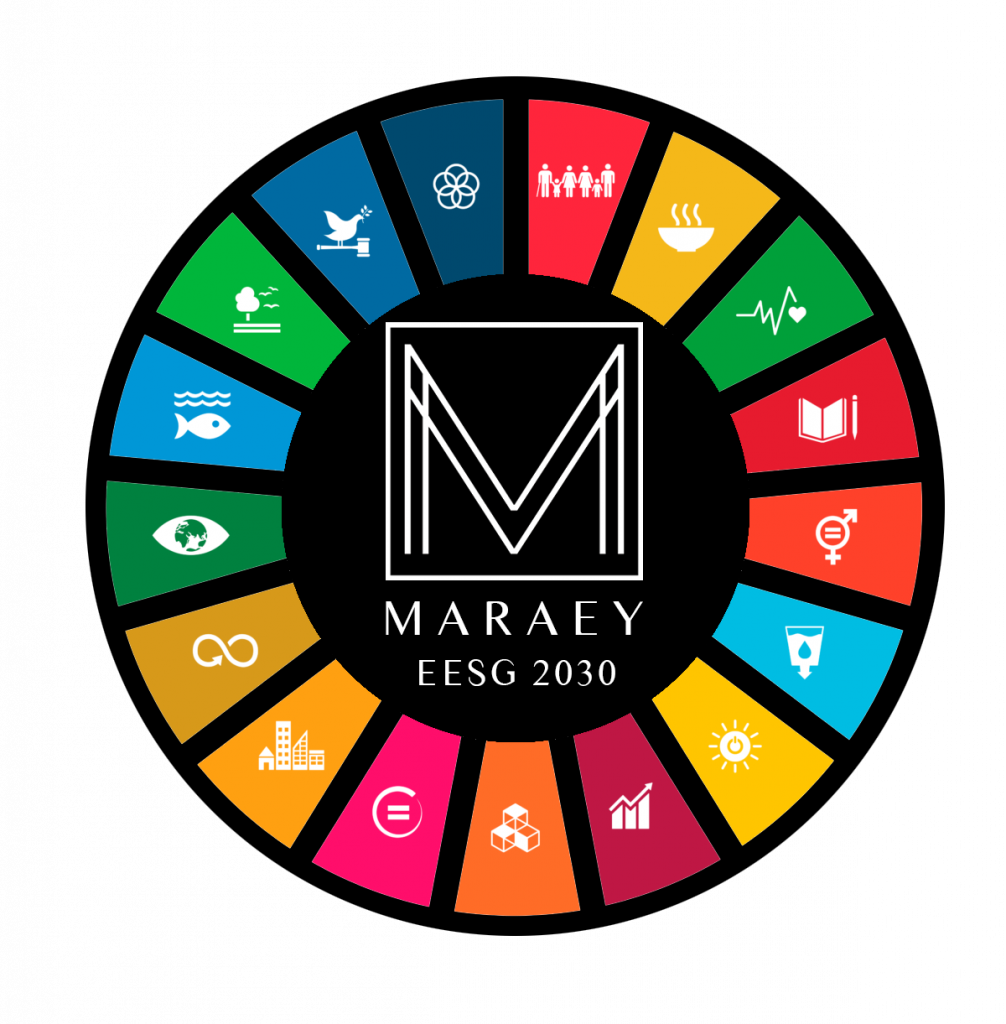
A benchmark for sustainability, the project pledges to achieve the best economic, environmental, social responsibility and governance indicators
MARAEY, a sustainability benchmark to be developed in Maricá, has announced the creation of its MARAEY EESG 2030 Agenda, with investments in order of R$ 1 billion over the next nine years, which accounts for approximately 10% of the project’s overall investment. Despite a recent court ruling which affects progress to achieve the licence for the project, MARAEY’s executives are confident in the final decision and have confirmed that they will take all legitimate legal action to get the licence and bring MARAEY to fruition, relying on the Judicial Power to authorise the implementation of a project that represents a benchmark in terms of sustainability, with a positive impact on the population of the State of Rio de Janeiro.
Embracing the EESG 2030 agenda is one of the areas it is progressing towards, with a timeline of priority actions to address a combination of economic (E), environmental (E), social responsibility (S) and governance (G) indicators. Work is set to begin once the Installation Licence is issued for the project by the State Environmental Institute (INEA).
“IDB Brasil, the company in charge of MARAEY, and our entire team are working to resume the licence application process as soon as possible. It is our mission to deliver a unique and innovative project to Maricá that will drive progress not only in this eastern Brazilian region, but all across the State of Rio de Janeiro,” says Emilio Izquierdo, CEO of MARAEY.
The undertaking, which has already been awarded internationally recognised seals such as BIOSPHERE and Sustainable SITES Initiative GOLD precertification, has joined the United Nationals Global Compact, confirming its commitment to work towards the global sustainability agenda in line with the international initiative’s 17 Sustainable Development Goals (SDGs) set for 2030.
Emilio Izquierdo argues that it is urgent to invest in EESG, which reinforces the MARAEY mission: “By materialising this project, we aim to champion the EESG debate in tourist-residential undertakings because we are a benchmark for environmental sustainability. MARAEY will also have a hugely positive impact on economic and social aspects, with significant investments, job creation, training and hiring local manpower, as well as legalising property and granting deeds of ownership for members of the Zacarias fishing community. And we also intend to move forward by investing in a clear agenda for governance indicators,” explains Mr Izquierdo.
MARAEY EESG ACTIONS BY 2030
Efforts towards the MARAEY 2030 Agenda will firmly continue once the infrastructure work begins, with a timeline of constant actions to be comprehensively deployed in EESG areas, ever in connection with the United Nations Sustainable Development Goals (SDGs).
Environment
On the environmental front, special mention goes to the creation of the second-largest Private Natural Heritage Reserve of restinga forest in the State of Rio de Janeiro, covering almost 440 hectares, along with another 249 hectares of restored native vegetation, adding up to a protected environmental area that spans 81% of MARAEY’s 845 hectares.
Another resource used to preserve wildlife is the degraded area environmental recovery programme, as well as a plan to rescue and care for endangered species in a nursery. Once the programme is implemented, it is estimated that native vegetation will be restored in over 120 hectares of restinga forest compared to the situation prior to MARAEY.
Other initiatives in the pipeline include building a system to catch and use rainwater, treating waste water from the complex using tertiary technology which transforms effluents into reusable water, and producing part of the project’s energy demands from renewable energy sources such as solar, wind, geothermal and biomass.
MARAEY will also be laying a 20 km bike lane, the longest in any private real estate development in Brazil, which will link up to Maricá’s cycling network, as well as implementing policies and subsidies to make the vehicles in the undertaking mostly hybrid or electric.
These actions are aligned with five SDGs:
SDG 6 (clean water and sanitation) – treating waste water promotes the circular economy by turning it into an asset as reusable water.
SDG 7 (Affordable and clean energy) – more than half of the power consumed in MARAEY’s outdoor areas will be generated by renewable sources.
SDG 13 (Climate action), fostering environmental protection and the ability to capture CO2.
SDG 14 (Life below water) – with programmes to recover the Maricá Lagoon, restore native species and rescue craft fishing.
SDG 15 (Life on land) – carrying out Basic Environmental Plans to preserve over 800 species of animals and 522 types of plants.
SDG 17 (Partnerships for the goals) – setting up an academic research centre focussing on the ecosystem in collaboration with some of the country’s top universities.
Social responsibility
In social terms, some of the most significant contributions include legalising deeds of ownership for the Zacarias community, urbanising land with the same infrastructure as the rest of the undertaking, and creating support programmes to revitalise craft fishing and restore the local culture, as well as treating waste water using tertiary technology for all residents to turn effluents into reusable water.
“The Zacarias community is one of the project’s greatest values. Nearly 200 families living in the MARAEY area stand to gain from receiving official deeds of ownership for their properties. It is also our goal to foster the local culture and fishing with programmes to restore the Maricá Lagoon, recover native species, and bring back and raise awareness of the Zacarias family memory by creating the Craft Fisherman’s House,” explains Luciana Andrade, the project’s Director of Sustainability.
These actions will also have a positive impact on the quality of the Maricá Lagoon, providing fishermen with a broader and better consumption market. Furthermore, up to 0.7% of the project’s overall revenue will go to the MARAEY Institute to be invested in environmental protection, training and equality programmes.
MARAEY is also embracing its social-cultural commitment by ensuring high-quality, inclusive and equitable education, the kind that underpins values such as biodiversity and promotes learning based on principles such as respect for differences and the right to equal opportunities. As well as creating the Hospitality and Haute Cuisine University and the Maricá Training Centre, the initiative also involves educational and qualification collaborations and agreements with the local Council and other specialised institutions.
These social responsibility actions are in line with the following SDGs:
SDG 3 (Good health and well-being) – creating a hospital which will help the community and support research, as well as education and prevention campaigns.
SDG 4 (Quality education) – setting up public-private partnerships to drive professional qualification.
SDG 5 (Gender equality) – creating professional opportunities and development based on equality.
SDG 11 (Sustainable cities and communities) – implementing initiatives for a balanced use of natural resources, new technology in construction processes, energy efficiency and renewables (smart city and eco-mobility).
They are also aligned with publicly-driven SDGs:
SDG 1 (No poverty) – through the action plan to ensure that all people have the same rights to economic resources and access to fundamental services.
SDG 2 (Zero hunger and sustainable agriculture) – launching social action campaigns conducted by the MARAEY Institute and corporate volunteering to collect food and share it out among vulnerable groups.
SDG 10 (Reduced inequalities) – in an area developed sustainably, efficiently, accessibly, inclusively and with balance.
Governance
The governance agenda – which rests on the basic principles of corporate social responsibility, transparency, integrity, legal compliance and respect for human rights – starts with initiatives such as redefining the MARAEY Board, including specific policies to combat gender inequality, and hiring independent advisers who are separate from the organisation’s management. Setting up the MARAEY Institute will involve launching social action programmes with collaborating companies, subcontractors and providers.
These initial actions are aligned with four SDGs:
SDG 5 (Gender equality) y SDG 10 (Reduced inequalities).
SDG 16 (Peace, justice and strong institutions) – thanks to policies for the prevention of corruption, fraud and bribery and internal control policies.
SDG 17 (Partnerships for the goals) – collaborating with public and private organisations to drive sustainable development.
Economy
In economic terms, MARAEY believes in responsible tourism and in inclusive and sustainable economic growth. The private investment forecast to develop the project is in order of R$ 11 billion, expecting R$ 7.2 billion to be collected in tax over the first 14 years (construction and consolidation of sales), followed by over R$ 1 billion per year once fully up and running. The economy of the State of Rio de Janeiro is predicted to warm up as 36 thousand jobs are created once MARAEY is in full operation.
These steps towards economic progress are aligned with:
SDG 8 (Decent work and economic growth) – ensuring a safe and healthy working environment and protecting labour rights.
SDG 9 (Industry, innovation and infrastructure) – with the project supporting new technologies and research within an ecosystem of leading companies in their fields of work.
SDG 12 (Responsible consumption and production) – focussing on responsible tourism, sustainable consumption and waste management, as well as promoting local produce.
EESG ETCHED INTO THE MARAEY DNA
MARAEY’s Executive Manager, David Galipienzo, highlights the organisation’s current values to underline its future EESG commitments.
MARAEY TO TRANSFORM THE PROJECT´ S WASTE WATER INTO REUSABLE WATER
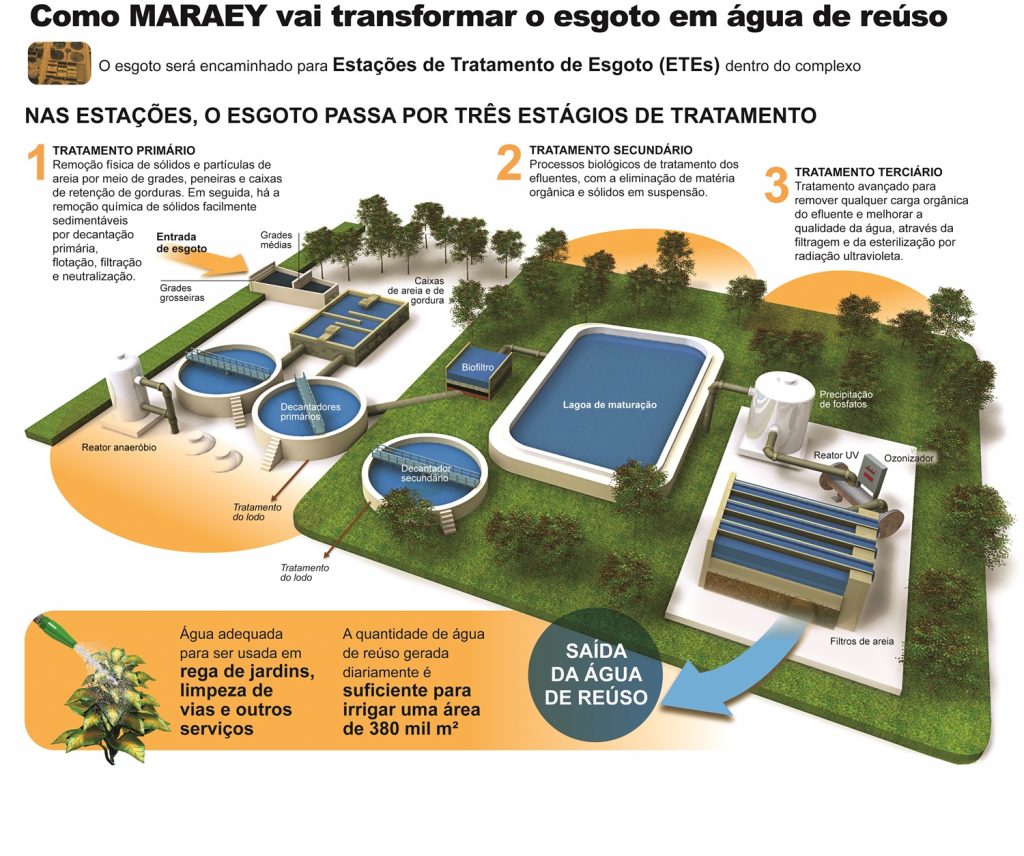
MARAEY, the main sustainable tourist-residential development in Brazil, announced this week that all waste water generated in the complex will be treated using tertiary technology to turn effluents into reusable water for other purposes. The sanitation model, which is considered the most efficient in the country, will make use of this treated water for garden irrigation, roadway cleaning and other essential services. The undertaking, set to be built on the Costa del Sol in Maricá, is close to achieving its Installation Licence from the State Environmental Institute (INEA), which would allow infrastructure work to get underway, including sanitation.
The decision to use tertiary water treatment, which fosters a circular economy by allowing waste water to be repurposed as an asset, is part of a package of measures lined up within the MARAEY EESG Agenda, including various structural initiatives in the fields of economy, environment, social responsibility and governance.
MARAEY’s Executive Manager, David Galipienzo, explains the advantages of this technology.
Waste water from the project will be channelled into Waste Water Treatment Plants (ETEs), where it will undergo several major stages of treatment divided into three phases, producing quality water in better condition than can be found in the Lagoon itself. The first phase consists in physically removing solids, followed by phase two with biological processes to treat the effluents, and ending with phase three, the most advanced, which involves sterilisation through ultraviolet radiation.
Repurposed water will be used to water gardens
MARAEY plans to reuse the water obtained from its waste water treatment plants (ETEs). It is estimated that the amount of waste water repurposed every day once in full operation will average roughly 60 litres per second – enough to irrigate approximately 380 thousand m2. Another sustainable water-related solution in the pipeline involves catching rainwater using a road catchment system and storing it in specific tanks to be used once it has been filtered and sterilised.
About MARAEY
MARAEY is set to be developed on Brazil’s Costal del Sol in Maricá. The tourist side of the undertaking will involve four five-star hotels welcoming an average of 300 thousand tourists every year. The project, guided by the smart city philosophy, will also feature various kinds of homes with a comprehensive range of services such as a school, hospital, international hospitality university, shops and businesses, as well as a host of leisure activities and sports. Having achieved worldwide seals such as BIOSPHERE and SITES GOLD precertification, MARAEY rises as a global benchmark for sustainability, quality and design.
MARAEY will also feature the longest bike lane in any private development in Brazil, measuring 20 km long, and aims for 55% of the fleet of vehicles used in the development to be electric or hybrid.
With barely 6.6% of the undertaking’s 860 hectares of land to be used for construction, it will be home to the second largest Private Natural Heritage Reserve (RPPN) of restinga forest in the State of Rio de Janeiro. As regards the 200 fishing families who live in the local Zacarias community, they stand to gain from seeing their properties legalised and receiving deeds of ownership, as well as an urban planning and infrastructure plan that meets the same standards and services as the rest of the project, and constant support for the local culture and fishing.
The private investment forecast is in order of R$ 11 billion, expecting R$ 7.2 billion to be collected in tax over the first 14 years (construction and consolidation of sales), followed by over R$ 1 billion per year once in operation and 36 thousand new jobs when MARAEY is fully up and running.
HALF OF THE POWER USED IN THE MARAEY TOURIST-RESIDENTIAL COMPLEX COMMON AREAS WILL COME FROM RENEWABLE SOURCES
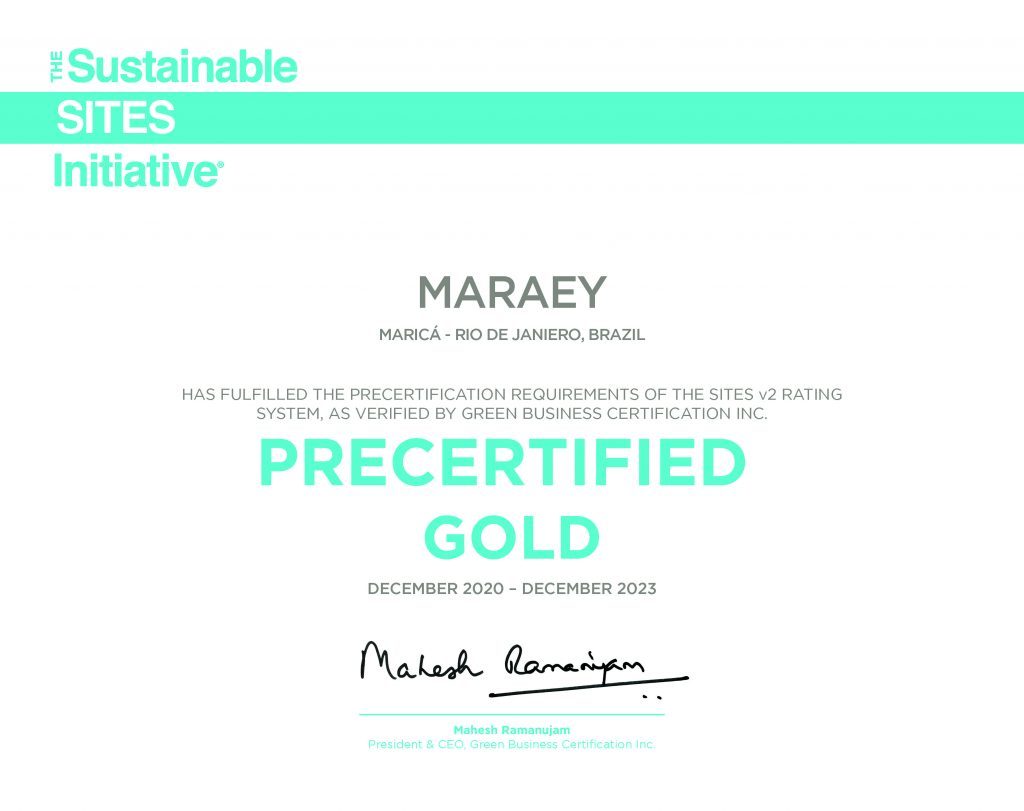
This promise is part of the Gold precertification granted to the project by the Sustainable SITES Initiative® for sustainable environments, making this the only pre-certified mixed-use developoment in South America.
The MARAEY undertaking, which is planned to be built in Maricá on Rio de Janeiro’s Costa del Sol, has just received precertification from SITES (Sustainable SITES Initiative®) in the Gold category. Using renewable energy was one of the key criteria considered when rating the tourist-residential complex for this sustainability seal. More than 50% of the electricity consumed in MARAEY’s outdoor areas will be generated by renewable sources, including solar power, biogas and mini wind energy, serving an estimated population of 70 thousand people including residents, service providers, tourists and workers.
The v2 Credit System uses a 200-point scorecard with four levels of excellence, where SITES Gold is the second-best. SITES is a programme that fosters sustainable environmental development and can be used to boost a project’s sustainability, which includes implementing green infrastructure and enhancing its resilience.
As well as using solar panels, the team of technicians on the project are considering various forms of energy production based on renewables, such as biogas produced from treating waste water and wind power generated by mini turbines. Geothermal energy is another option under study which consists in the process of exchanging heat from the ground and using it in air conditioning systems to help lower electric energy consumption in buildings. The power produced by renewable sources will also be used for lighting in public and common areas within the complex and supplying irrigation systems in the gardens, sports facilities and leisure areas.
“Achieving SITES Gold precertification just goes to show how deeply embedded the concept of sustainability is in the MARAEY project, striving for coherence between what we propose, what we believe and what we offer. We will be the first to be pre-certified in the mixed-use category in all of South America. Out of the greatest tourist-residential undertakings, ours will have a cutting-edge structure in terms of the complexity and variety of sustainable energy sources,” stated Marcelo Galvão, MARAEY’s Technical Construction Director.
PIn order to achieve SITES precertification, initiatives are required to include strategic objectives linked to the following aspects during design, construction and operation:
– Preservation and promotion of native ecosystems
– Water conservation
– Sustainable drainage
– Energy efficiency
Repurposing water
When granting MARAEY the SITES Gold precertification, the programme also considered use of renewables and the implementation of strategies linked to water preservation. Along these lines, the project has proven that it will reuse the water obtained from its waste water treatment plants (ETEs). The estimated amount of waste water repurposed every day by the project will average roughly 60 litres per second – enough to irrigate approximately 380 thousand m2 with reused water.
Another sustainable water-related solution planned for the MARAEY project involves catching rainwater and storing it in special tanks to be used.
The water sourced from both the ETE plants and rainfall catchment will be used to water the gardens in common and public areas and the golf course. By doing so, MARAEY can avoid using drinking water for landscaping purposes.
Perpetual preservation of the restinga forest
Being a project that blends into and protects its environment has always been at the core of the MARAEY philosophy. The tourist-real estate complex will house the second-largest Private Natural Heritage Reserve (RPPN) of restinga forest in the State of Rio de Janeiro. Covering nearly 440 hectares, the RPPN will take up almost half of the overall surface of MARAEY and will be fully and perpetually protected.
Another way of preserving local wildlife involves an organic matter management plan for reforestation in degraded areas, as well as rescuing species. The layer of vegetation removed under legal authorisation will be treated and used to restore depleted areas. Following the project’s implementation, it is estimated that native vegetation will be recomposed in over 120 hectares of Maricá’s restinga forest compared to the situation prior to MARAEY.
Sustainable mobility
During the SITES Gold precertification process, MARAEY also scored points for promoting the use of hybrid and electric vehicles and for including a 20 km cycle lane, following the trend set by other large complexes featuring bike lanes that link up to municipal networks. Once it is ready, it will be the longest cycling path in a tourist-residential undertaking in all of Brazil. These lanes will add to Maricá’s existing cycling network, totalling 57.5 km in length.
Sustainable SITES Initiative® (SITES)
Sustainable SITES Initiative® or simply SITES® certification is managed by Green Business Certification Inc. (GBCI) and consists in the most comprehensive programme for designing, developing and maintaining sustainable environments.
The SITES credits system promotes best practice in ecological restoration, both on constructed land and in related areas. The programme supports and restores the functions of healthy ecosystems, both in urban and rural areas. From plants and soils to water and materials, SITES improves communities through responsible design, enhancing the functions of buildings and businesses by means of affordable and environmentally-friendly solutions and creating a strong link between people and nature. SITES connects design with ecology and people with places.
SITES was originally developed thanks to the collaborative and interdisciplinary efforts of the American Society of Landscape Architects, the University of Texas’ Lady Bird Johnson Wildflower Center and the United States Botanic Garden.
Its credit system can be applied to undertakings located in areas with or without buildings and provides the experience gained from a two-year pilot programme including over 100 projects. Initiatives having achieved certification include corporate headquarters, national and municipal parks, academic campuses and private residences. For more information, visit www.sustainableSITES.org. It is important to note that SITES precertification goes to projects in the planning phase, whereas SITES certification applies to new constructions or major refurbishments in existing establishments, where a project must be fully constructed to be certified.
About MARAEY
The MARAEY project is set to be developed on Brazil’s Costal del Sol in Maricá. The tourist side of the undertaking will house four five-star hotels welcoming an average 300 thousand tourists per year: a luxurious eco-boutique resort, a luxury themed resort, a hotel designed to be the country’s most iconic seaside events venue, and MARAEY Golf Resort surrounding an international 18-hole golf course.
The project also offers various types of homes (apartment blocks, duplexes and villas) with a comprehensive range of services such as a school, hospital, shops and businesses, as well as a host of leisure activities and sports. MARAEY also includes an international hospitality university to turn Maricá into a hub for specialized training in Latin America.
With barely 6.6% of the undertaking’s land intended to be used for construction, it is set to be home to the second-largest Private Natural Heritage Reserve (RPPN) of restinga forest in the State of Rio de Janeiro. The project also comprises an environmental research centre supported by renowned academic institutions such as UFRJ, UFF, UFRRJ, UFES and FURG.
MARAEY is the first privately-driven tourist destination in the world to receive the BIOSPHERE seal from the Responsible Tourism Institute (RTI), an organisation backed by the support and acknowledgement of the United Nations Environment Programme (UNEP). With this certification, the project shows its commitment to develop in line with the 17 United Nations Sustainable Development Goals (SDGs) and the latest directives of the Paris Climate Agreement.
Sustainability will also be a guiding principle for mobility within the complex. Covering a total surface of 840 hectares, MARAEY will feature the longest cycle lane in any private initiative in Brazil, spanning 20 km in length, as well as offering shared bikes and encouraging the use of sustainable transport in electric and hybrid vehicles for the movement of tourists and residents.
The private investment forecast for the undertaking is in order of R$ 11 billion, expecting R$ 7.2 billion to be collected in tax over the first 14 years (construction and consolidation of sales), followed by over R$ 1 billion per year once fully up and running. The economy of the State of Rio de Janeiro is predicted to warm up as 36 thousand jobs are created once MARAEY is in full operation.
There are around 200 fishing families living in the Zacarias community inside the area of the project who stand to gain from legalised land use and being given deeds of official ownership and residence. IDB Brazil will also boost the local culture and fishing with programmes to restore the Maricá Lagoon, recover native species, and bring back and raise awareness of the Zacarias family memory by creating the Craft Fisherman’s House.
SPECIALISTS DEBATE ABOUT THE FUTURE OF SUSTAINABLE TOURISM
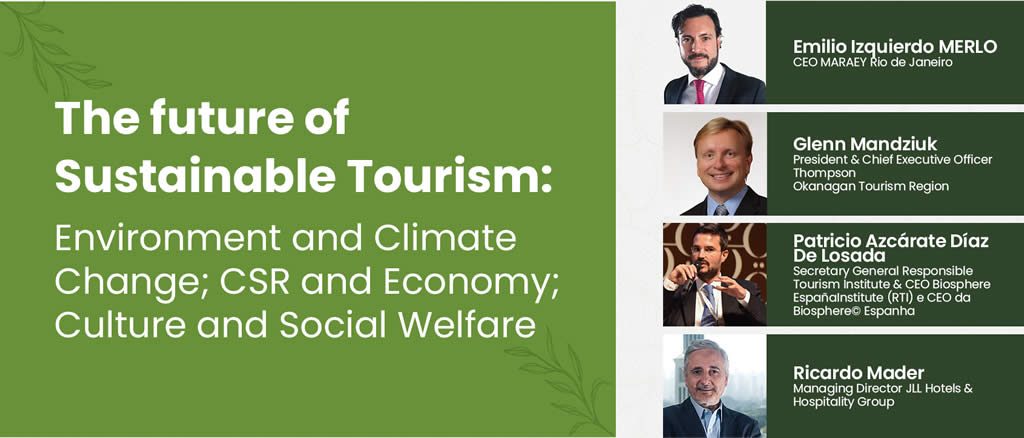
Entity leaders met in a webinar to discuss the importance of environmental, economic and sociocultural balance in the development of tourist destinations
Representatives from tourism sector entities met last Wednesday in a Webinar to debate about the future of sustainable tourism. The meeting was held on the channel created for the MARAEY project, the main touristic-real estate hub in Brazil. Acting as moderator was the General Secretary of the Responsible Tourism Institute (RTI) and CEO of Biosphere Spain, Patricio Azcárate, with the participation of Emilio Izquierdo Merlo, CEO of IDB Brasil (the company responsible for MARAEY), Glenn Mandziuk, President and CEO of Thompson Okanagan Tourism Region (TOTA), and Ricardo Mader, Director of JLL Hotels & Hospitality Group.
Mr. Azcárate opened the debate speaking about the importance of tourist destinations being aligned with sustainability, which is the aim of the Biosphere certification stamp granted by the Responsible Tourism Institute (RTI), the organization that was born in 2017 during International Sustainable Tourism year, after conferences sponsored by UNESCO and the World Tourism Organization. In order to obtain it, it is necessary to work on a series of goals divided in three main areas: environment and climate change, economy, culture and social welfare.
During the debate Mr. Izquierdo Merlo highlighted the significance of being part of the Biosphere community. MARAEY is the first private project in the world to receive this certification in the ‘Tourist Destination’ category. With the stamp, the project reinforces its commitment to following the 17 UN Sustainable Development Goals (SDGs) and the more recent guidelines of the Climate Agreement in Paris.
Mr. Mandziuk talked about the TOTA experience in British Columbia, in Western Canada, with an analysis of the progress made in this region that received Gold Biosphere certification in 2017. He showed how they had built responsible and sustainable tourism on values such as economic growth, dialogue with stakeholders and local communities, joining technology with sustainable tourism and adding value to the local DNA.
In his presentation, he also supported the construction of a development that brings progress for everybody, while respecting the history and tradition of the native communities. He also said that a tourist destination for everybody should involve inclusion and accessibility projects. “When we started the process and talked to the communities, 80% of the income generated by tourism came during the first 45 days of the year. This was in 2012. Something would happen in that period and companies would have to close. We all work with the same purpose, in a huge area, and share common relevant values, both for the local community and for entrepreneurs and visitors. In 2018, we managed to extend that period to 110 days, and now we are determined to achieve 200”, states the executive.
To talk about the future, Emilio Izquierdo showed that MARAEY, developed in a coastal area of 844 hectares with 8.5 kilometers of beaches, will be a totally innovative project that will include Maricá and Rio State in the list of the most important tourist destinations in the world. MARAEY aims to become a worldwide benchmark for sustainability, with a sound environmental, economic and sociocultural balance, incorporating tourism, residential properties, services and the creation of the second largest Reserva Particular do Patrimonio Natural (RPPN) of restinga in Rio State. The project will have a land occupation of barely 6.6%, less than half that permitted in the plans.
“The RPPN will be a natural paradise with permanent protection, open to the public, receiving sustained funding from the project, hotel incomes, companies located in MARAEY and residents in the complex. Sustainable tourism will be fostered by assigning 0.7% of total income from the hotels to environmental, sociocultural and educational sustainability projects”, said the CEO of IDB Brasil. In the construction of an integral sustainable destination, Mr. Izquierdo highlighted the importance of public-private collaboration in the development of the MARAEY Project with the support of the Instituto Estatal de Medio Ambiente (INEA), the Maricá municipality, environmental departments from five universities (UFRJ, UFF, UFRRJ, UFES and FURG), NGOs, architects, engineers and specialists.
The area director of Hotels and Hospitality of JLL Hotels & Hospitality Group, Ricardo Mader, closed the meeting by underlining the importance that sustainability has gained in hospitality in recent years. He said that the increase of travelers has overcrowded big tourist cities – mainly in summer– and because of this there is a significant audience looking for new destinations. MARAEY can provide this as a preferential destination and a highly sustainable project that will become a worldwide benchmark.


